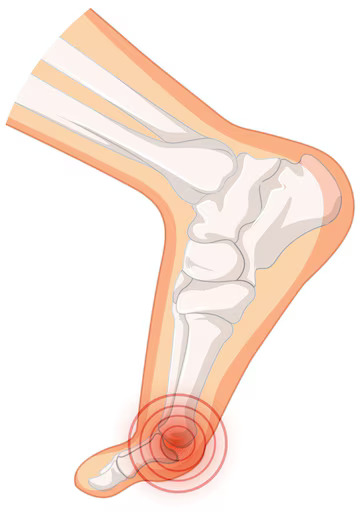Effective Home Remedies for Cuboid Bone Pain Relief
The cuboid bone is a small yet vital bone located on the lateral side of the foot, playing an essential role in movement and stability. Injuries to the cuboid bone, such as cuboid syndrome, can cause significant pain and discomfort, often resulting from repetitive strain, improper footwear, or trauma. Treating this injury at home requires a combination of strategies aimed at alleviating pain, reducing inflammation, and restoring mobility.
In this comprehensive guide, we will walk you through the best home treatments for managing a cuboid bone injury effectively.
Table of Contents
Cuboid Syndrome: What is it?
Cuboid syndrome occurs when the cuboid bone is partially dislocated or becomes misaligned with surrounding bones. This often leads to pain on the outside of the foot, swelling, and difficulty in walking or bearing weight. It can result from:
- Overuse from activities like running or jumping.
- Poor foot mechanics or improper footwear.
- Sudden trauma or twisting injuries.
Addressing these symptoms as early as possible is essential to prevent long-term issues.
Home Treatments for a Cuboid Bone Injury
The first few hours or days following an injury to the cuboid bone are critical for recovery. Here’s what you should do:
Rest and Immobilize the Foot
The first step to treating a cuboid bone injury is to rest the foot as much as possible. Reducing the amount of pressure and strain on the cuboid bone allows it to heal naturally. To immobilize the area:
- Avoid weight-bearing activities, such as running or jumping.
- Use crutches to limit pressure on the foot.
- Wear a soft cast or supportive shoe if recommended by a healthcare professional.
Rest is crucial, as overuse can worsen the injury and prolong recovery.
Ice Therapy
Ice therapy is one of the most effective methods for reducing pain and swelling in the injured cuboid bone. To apply ice therapy:
- Use an ice pack wrapped in a towel or a cold compress to apply to the injured area for 15-20 minutes.
- Repeat this process 3-4 times daily during the first 48 hours post-injury.
- Avoid direct skin contact with ice, as it may cause frostbite.
This therapy helps reduce inflammation and provides temporary pain relief.
Compression to Alleviate Discomfort
Compression aids in reducing swelling and supporting the cuboid bone. Using an elastic bandage, you can apply compression to the foot. When applying compression:
- Wrap an elastic bandage around the injured area, ensuring it’s snug but not overly tight.
- Avoid wrapping too tightly, as it may restrict blood flow.
- Wear the bandage during the day and remove it at night to allow proper circulation.
Compression can be particularly helpful in the early stages of recovery.
Elevation for Swelling Reduction
Elevation is a simple yet effective way to reduce swelling and improve circulation. To properly elevate the foot:
- Keep the foot elevated above heart level as often as possible.
- Use pillows to support the foot when lying down.
- Avoid sitting with the foot on the ground for prolonged periods.
Elevation allows fluid to drain away from the injured area, reducing swelling and promoting faster healing.
Foot Stretching Exercises
Gentle stretching exercises can help improve the mobility of the foot and reduce stiffness around the cuboid bone. One of the most effective stretches for cuboid syndrome includes the calf stretch:
- Stand facing a wall, place your hands on the wall for support, and extend the injured foot behind you.
- Keep the injured foot flat on the floor, and slowly lean into the wall.
- Hold for 20-30 seconds and repeat 2-3 times a day.
Another beneficial exercise is the plantar fascia stretch. This exercise helps alleviate tension along the bottom of the foot, which can relieve cuboid pain:
- Sit down with your legs extended, place a towel around the ball of your foot, and gently pull back toward your body.
- Hold for 15-20 seconds and repeat a few times daily.
Cuboid Whip Manipulation
The cuboid whip technique is a manual manipulation often performed by professionals, but a variation can be attempted at home to relieve pressure on the cuboid bone.
This technique involves pulling the toes while applying gentle pressure to the cuboid area. Though it is recommended to consult a professional before attempting this, it can sometimes provide immediate relief.
Use Orthotic Inserts
Custom-made or over-the-counter orthotics can also aid in treating cuboid syndrome by redistributing pressure away from the affected area. Arch supports or lateral wedge orthotics can help realign the bones of the foot and relieve tension on the cuboid bone. Make sure to consult with a podiatrist to find the best orthotic for your foot type.
Preventing Future Cuboid Bone Injuries
To avoid recurring cuboid bone injuries, consider incorporating these preventive measures into your routine:
- Wear Supportive Shoes: Opt for shoes that provide adequate arch support and cushioning to reduce impact on the foot.
- Gradually Increase Activity Intensity: If you’re involved in sports or high-impact activities, build up intensity slowly to avoid overloading the foot.
- Warm-Up and Stretch: A proper warm-up, including foot and ankle stretches, can help improve flexibility and reduce injury risk.
- Maintain Muscle Strength and Flexibility: Engage in regular strengthening exercises for the feet, ankles, and calves to support the arch and reduce strain on the cuboid bone.
Conclusion
Treating a cuboid bone injury at home requires patience and a combination of rest, ice, elevation, and strengthening exercises. By incorporating supportive footwear and self-care techniques like massage, you can alleviate pain and promote healing.
However, do not hesitate to seek medical help if your condition does not improve or worsens. Proper management will ensure a full recovery and prevent future injury.
